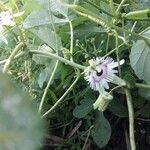Leaf-lamina 4–11 × 5–15 cm., 3-lobed, the lobes acute, the median ovate or ovate-lanceolate, usually narrowed at the base, the lateral ones divergent, margin undulate-dentate or denticulate or subentire, deeply cordate at the base, membranous, 3-nerved, dark green and hispidulous above, paler and pilosulous beneath; petiole up to 6 cm. long, flattened, hispidulous or pilosulous, with 2 thickly stipitate glands 1·5 × 0·8–1 mm. within 1 cm. of the apex; stipules c. 6 × 3 mm., ovate, acuminate, minutely hispidulous.
A climbing herb. The stems are yellow. They are grooved and slightly four angled. There are tendrils in the axils of leaves. The leaves are alternate and have 3 triangle shaped lobes. They are heart shaped at the base. There are teeth around the edge. The leaf stalks are 6 cm long. The flowers occur singly. They are 2-3 cm across. They are white and mottled with red. The fruit are 2 cm across. They are blue-green and roughly hairy.
Sepals 10–15 × 3–4 mm., linear-oblong, obtuse, green, densely hispidulous to glabrescent outside, white mottled with red inside, with a 3·5 mm. long horn-like arista below the apex.
Stems yellowish, inconspicuously 4-angled, grooved, glabrate below, sparingly hispidulous upwards; internodes up to 7 cm. long.
Seeds 4 mm. long, very slightly compressed, obcordate-obovoid, abruptly tapering at the base, coarsely reticulate.
Corona-filaments in a single row, the filaments 5–6 mm. long, filiform, white, banded with blue or violet.
Peduncles 1–2 cm. long, solitary or geminate, ± densely hispidulous, not ending in a tendril.
Bracts 2·5–3 mm. long, setaceous, at c. 1 cm. below the base of the flower, ± approximate.
Nectar ring annular, placed midway between the Operculum and the base of the gynophore.
Operculum membranous, plicate, slightly incurved and crenulate at the margin.
Limen membranous, adnate to the floor of the calyx-tube, the margin free.
Fruit 2 cm. in diameter, globose, hispidulous, glaucous.
Petals 6–8 × 2–4 mm., linear-lanceolate, obtuse, white.
Calyx-tube patelliform or campanulate.
Ovary subglobose, densely pubescent.
Herbaceous perennial climber.
Flowers 2–3 cm. in diameter.

